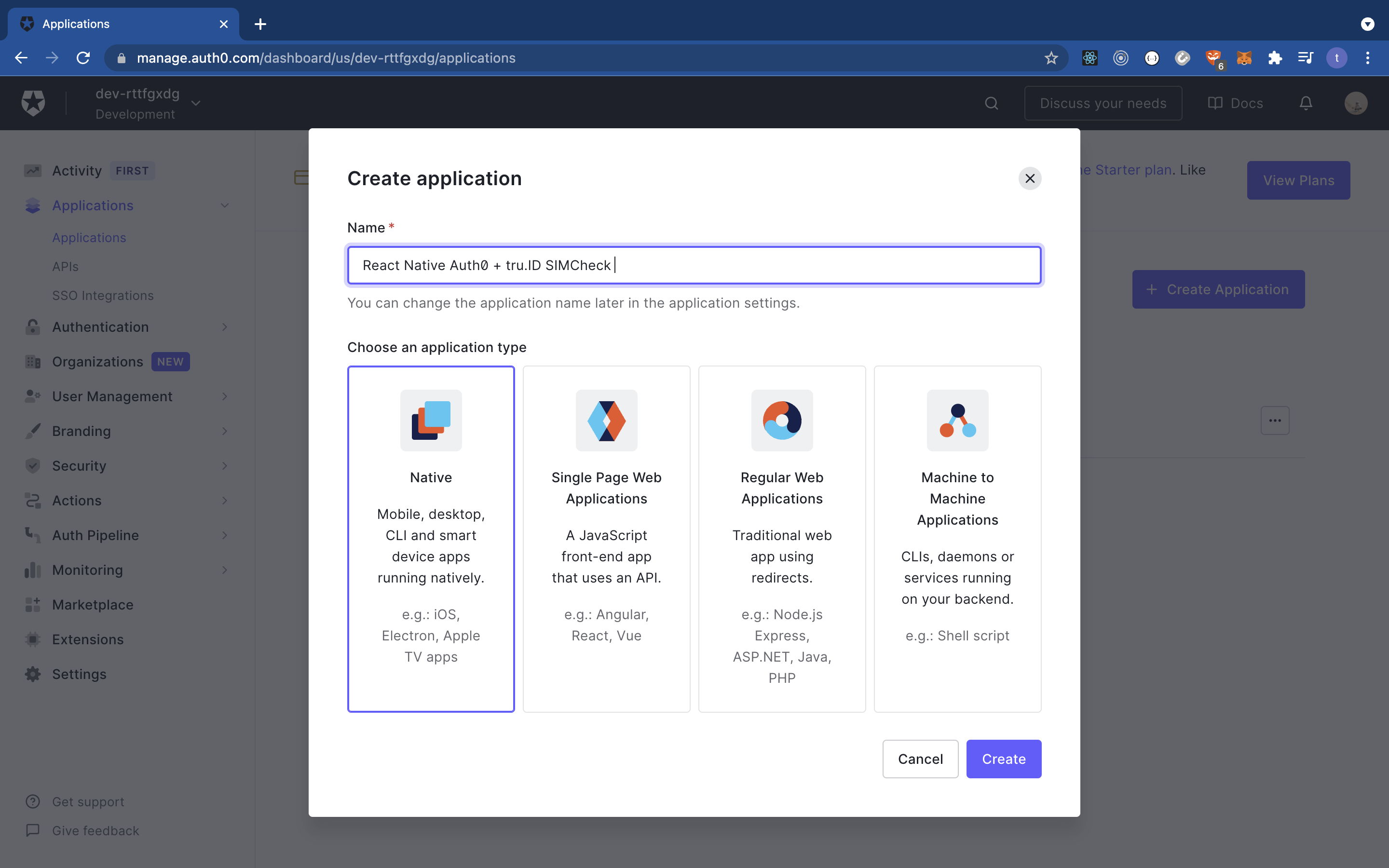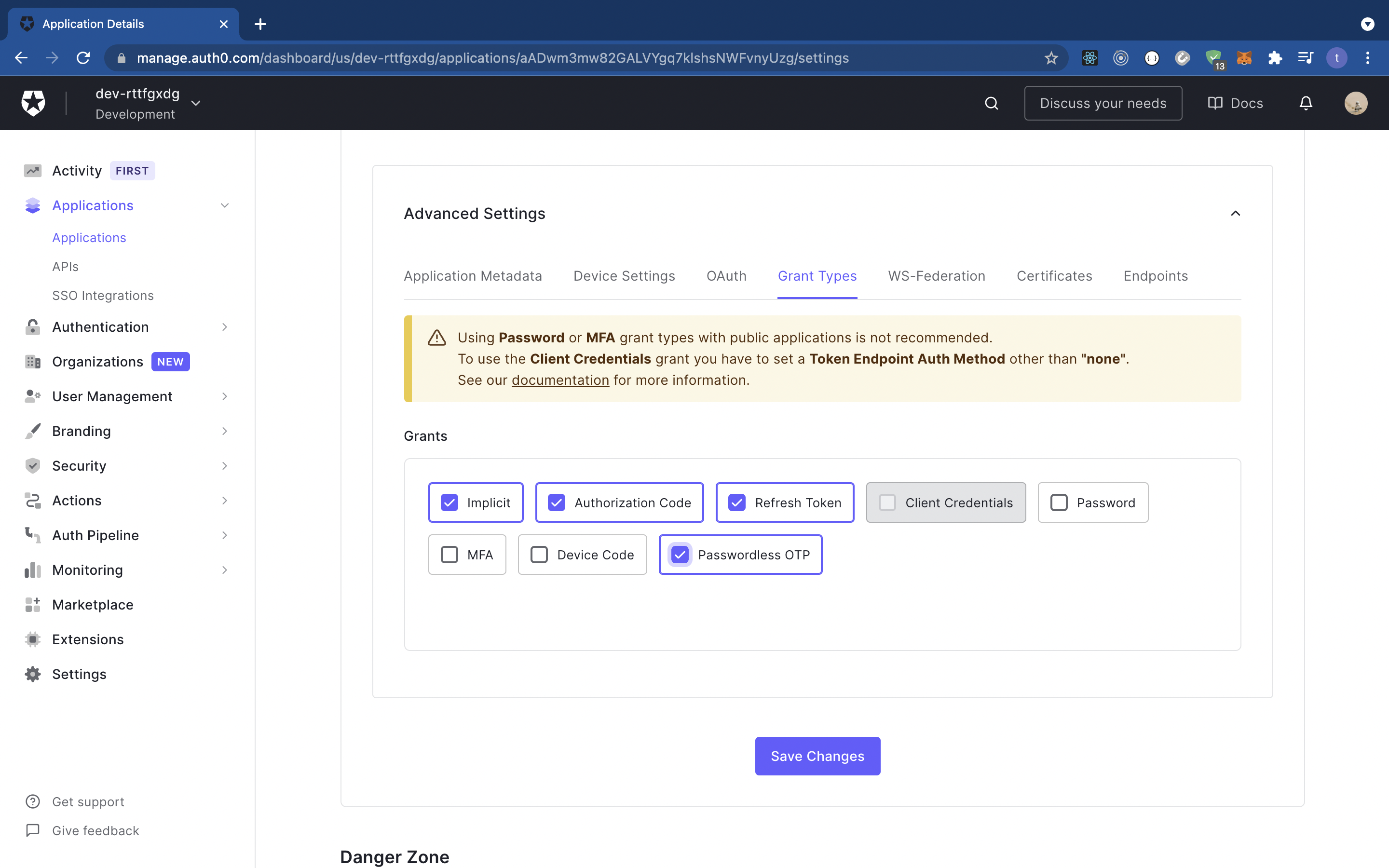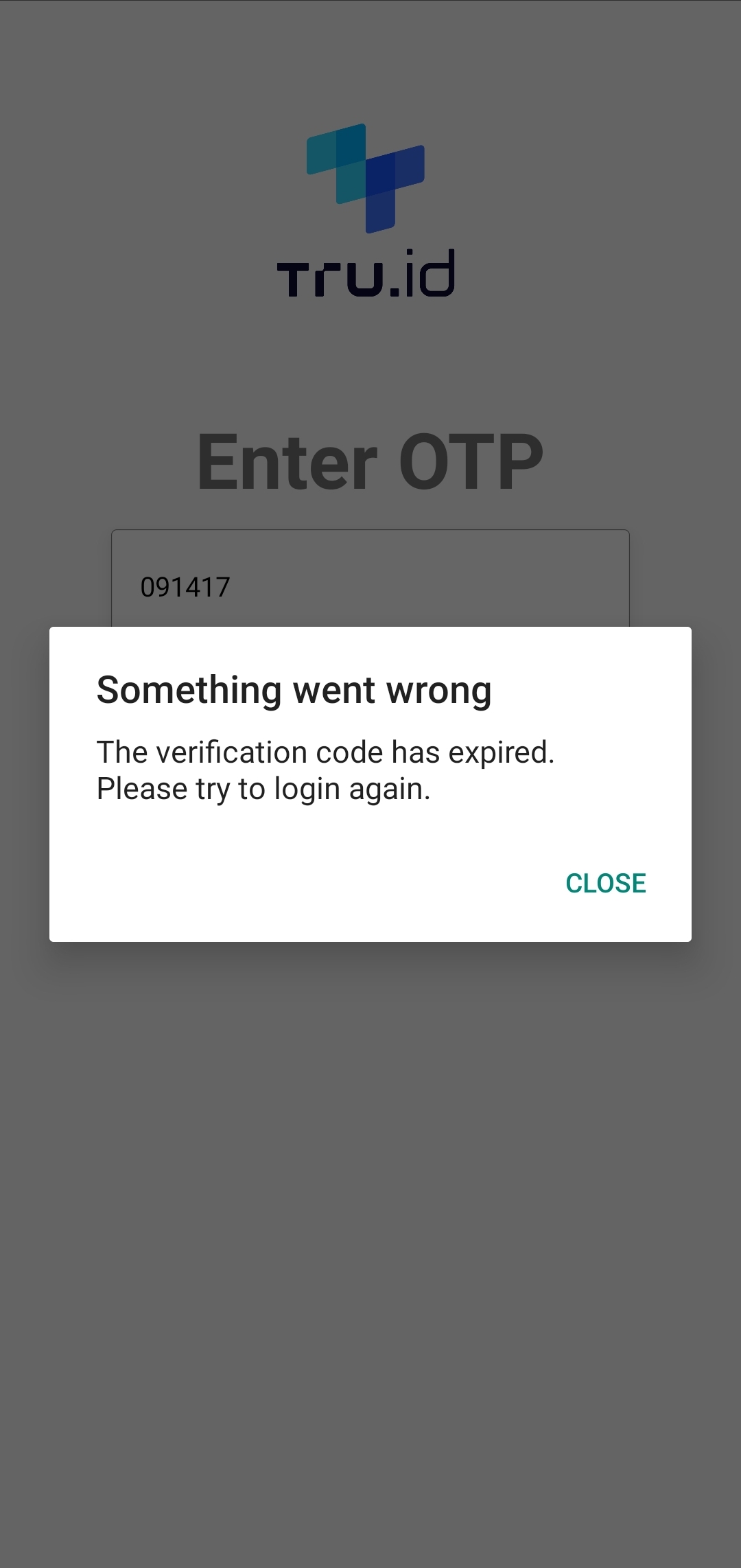In this tutorial, you'll learn to add SIM swap detection using IDlayr SIMCheck to a React Native application authenticated with Auth0's passwordless login.
Auth0 is an identity provider (IDP) that provides authentication and authorization strategies supporting out-of-the-box solutions for social, passwordless, and credential logins.
Twilio is a communications platform as a service (CPaaS), which is the default SMS one-time password (OTP) service used by Auth0.
The IDlayr SIMCheck API provides information on whether a SIM card associated with a mobile phone number has changed in the last seven days. This check provides an extra layer of security in your application login flows and can be used to detect attempted SIM swap fraud. It can be used to augment existing two-factor authentication (2FA) or anti-fraud workflows.
If you want to dive into the finished code, you can find it on GitHub.
Requirements
To follow along with this tutorial, you'll need:
- A IDlayr Account
- An Auth0 Account
- A Twilio Account
- A mobile phone with a SIM card and mobile data connection
- An Ngrok account
Getting started
In your terminal, clone the starter-files branch with the following command:
git clone -b starter-files https://github.com/tru-ID/auth0-passwordless-authentication-react-native.git
If the finished code is what you're interested in, then the command below will clone the repository with the main branch as the active branch:
git clone -b main https://github.com/tru-ID/auth0-passwordless-authentication-react-native.git
npm install -g @tru_id/cli
tru login <YOUR_IDENTITY_PROVIDER> (this is one of google, github, or microsoft) using the Identity Provider you used when signing up. This command will open a new browser window and ask you to confirm your login. A successful login will show something similar to the below:Success. Tokens were written to /Users/user/.config/@tru_id/cli/config.json. You can now close the browser
config.json file contains some information you won't need to modify. This config file includes your Workspace Data Residency (EU, IN, US), your Workspace ID, and token information such as your scope.Create a new IDlayr project within the root directory with the following command:tru projects:create auth0-rn --project-dir .
auth0-rn directory and run the following command to clone the dev-server:git clone [email protected]:tru-ID/dev-server.git
dev-server directory, run the following command to create a.env copy of .env.example:cp .env.example .env
.env file, update the values of TRU_ID_CLIENT_ID andTRU_ID_CLIENT_SECRET with your client_id and client_secret in yourtru.json file.dev-server to the Internet for your mobile application to access your backend server. For this tutorial, we're using ngrok, which we've included in the dev-server functionality. So to start with, uncomment the following and populate them with your ngrok credentials:NGROK_ENABLED=true#NGROK_SUBDOMAIN=a-subdomain # Uncommenting this is optional. It is only available if you have a paid ngrok account.NGROK_AUTHTOKEN=<YOUR_NGROK_AUTHTOKEN> # This is found in the ngrok dashboard: https://dashboard.ngrok.com/get-started/your-authtokenNGROK_REGION=eu # This is where your ngrok URL will be hosted. If you're using IDlayr's `eu` data residency; leave it as is. Otherwise, you could specify `in` or `us`.
dev-server directory, run the following two commands:npm install # Installs all third-party dependencies in package.jsonnpm run dev # Starts the server
Setting up Auth0
Sign in to your account at Auth0, redirecting you to the dashboard when authenticated. The dashboard is similar to what's shown in the example below:

Create a new Auth0 application by clicking on the ‘applications’ pane on the left-hand side. Selecting this will route you to a new page. Click on the ‘Create application’ button to create a new application, as shown below:

Copy or rename the file .env.example to .env. Then within your Auth0 application, find your Client ID and Auth0 Domain and add the values of these two fields to the relevant variables within the .env file.
Enable passwordless authentication on Auth0
To enable passwordless authentication on Auth0, navigate to ‘Advanced Settings’, then ‘Grant Types’, and select ‘Passwordless OTP’ as shown in the screenshot below:

Next, hover over the ‘Authentication’ icon (on the dashboard to your left) and click ‘Passwordless’. The page loaded looks similar to what's shown in the example below:

Click on SMS and input the credentials as shown below. Auth0 uses Twilio, so be sure to grab the credentials from the Twilio Console.

Once you've set up your Twilio credentials, navigate to the ‘Applications’ pane on your Auth0 dashboard and enable your application as shown below:

Start the project
To start your mobile application, first install dependencies with the following command:
npm install
Depending on which physical device you're using, first, ensure you have a physical device connected, then run one of the two commands below:
npm run android#ornpm run ios
The application on your mobile device, when successfully installed, looks similar to what's shown in the image below:

Get the user's phone number on the mobile device
The first step is to add the state management and UI required to grab the phone number, which is needed for authenticating with Auth0 and required to perform the SIM Check.
Open the file src/App.js, and at the top of this function, add the following four lines:
const [phoneNumber, setPhoneNumber] = useState('')const [code, setCode] = useState('')const [otpSent, setOtpSent] = useState(false)const [loading, setLoading] = useState(false)
Now update the contents of the return() with the following:
return (<SafeAreaView style={styles.container}><View style={styles.content}><Image style={styles.logo} source={require('./images/tru-logo.png')} />{otpSent === false ? (<View style={styles.content}><Text style={styles.heading}>Login</Text><TextInputstyle={styles.textInput}placeholder="Number ex. +448023432345"placeholderTextColor="#d3d3d3"keyboardType="phone-pad"value={phoneNumber}editable={!loading}onChangeText={(value) => setPhoneNumber(value.replace(/\s+/g, ''))}/>{loading ? (<ActivityIndicatorstyle={styles.spinner}size="large"color="#00ff00"/>) : (<TouchableOpacity onPress={loginHandler} style={styles.button}><Text style={styles.buttonText}>Login</Text></TouchableOpacity>)}</View>) : (<View style={styles.content}><Text style={styles.heading}>Enter OTP</Text><TextInputstyle={styles.textInput}placeholder="Enter OTP Code"placeholderTextColor="#d3d3d3"keyboardType="default"value={code}editable={!loading}onChangeText={(value) => setCode(value.replace(/\s+/g, ''))}/>{loading ? (<ActivityIndicatorstyle={styles.spinner}size="large"color="#00ff00"/>) : (<TouchableOpacity onPress={otpHandler} style={styles.button}><Text style={styles.buttonText}>Submit code</Text></TouchableOpacity>)}</View>)}</View></SafeAreaView>)
Here you added the UI and state necessary. If the otpSent value is true, a different UI is rendered for submitting the OTP.
NOTE Make sure to replace the value of
baseURLwith your personal Ngrok URL in the format:https://{subdomain}.{region}.ngrok.io
The application on your mobile device should now look like this:

Create reusable error handlers
The next thing to do is create two reusable error handlers to address the two possible scenarios:
- a successful scenario
- and an error scenario.
Above the empty loginHandler definition in src/App.js, add the following two functions; errorHandler and successHandler:
const errorHandler = ({ title, message }) => {return Alert.alert(title, message, [{text: 'Close',onPress: () => console.log('Alert closed'),},])}const successHandler = () => {Alert.alert('Login Successful', '✅', [{text: 'Close',onPress: () => console.log('Alert closed'),},])}
The errorHandler function takes in a title and a message prop, which it then uses to render an Alert to the screen with those values.
The successHandler renders an Alert that the check was successful.
Handle user sign in
The next step is to handle the user's attempt to sign in. The application uses Passwordless Login with Auth0 to achieve this.
Replace your empty loginHandler function with the following functionality:
const loginHandler = async () => {setLoading(true)try {await auth0.auth.passwordlessWithSMS({phoneNumber,})setOtpSent(true)setLoading(false)} catch (e) {setLoading(false)return errorHandler({title: 'Something went wrong',message: e.message,})}}
Here, you set the value of loading to true, which serves as a visual indicator that something (an HTTP request) is taking place. Then the passwordlessWithSMS function is called, passing the phoneNumber, which sends an OTP to the number passed.
If there is a problem sending the OTP, the application catches the error and updates the UI to display this error. An example of the UI is shown in the image below:

The next step is to submit the OTP for verification. Locate the empty otpHandler function and populate it with the following contents:
const otpHandler = async () => {try {const result = await auth0.auth.loginWithSMS({phoneNumber: phoneNumber,code,})if (result) {setLoading(false)return successHandler()}} catch (e) {console.log(JSON.stringify(e))setLoading(false)return errorHandler({title: 'Something went wrong',message: e.message,})}}
The application submits the OTP and the user's phone number in the code above. The authentication request passes if the OTP and the user's phone number are linked, and the successHandler function gets called.
A failed authentication request means the OTP and the user's phone number are not linked, so the errorHandler function will be called to render a failed check.
A failed login will look similar to the example shown in the image below:

Adding SIM card-based authentication to our existing workflow
You've now successfully implemented functionality into the mobile application to authenticate with Auth0. The next step is to add IDlayr's SIM swap detection into the sign-up flow, using the SIMCheck API.
First, confirm the user's mobile phone supports the SIMCheck API, check whether the connection is a mobile data connection, and check whether IDlayr supports the user's mobile network operator. If these checks pass, the application proceeds to make a request to the API.
Install the tru.ID (IDlayr) React Native SDK, which contains this functionality:
npm install @tru_id/tru-sdk-react-native
Add the import of the tru.ID (IDlayr) SDK at the top of src/App.js:
import TruSdkReactNative from '@tru_id/tru-sdk-react-native'
Replace the contents of the loginHandler function with what's shown in the example below:
const loginHandler = async () => {setLoading(true)try {const reachabilityResponse = await TruSdkReactNative.openWithDataCellular('https://{DATA_RESIDENCY}.api.idlayr.com/public/coverage/v0.1/device_ip',)console.log(reachabilityResponse)let isMNOSupported = falseif ('error' in reachabilityResponse) {errorHandler({title: 'Something went wrong.',message: 'MNO not supported',})setLoading(false)return} else if ('http_status' in reachabilityResponse) {let httpStatus = reachabilityResponse.http_statusif (httpStatus === 200 &&reachabilityResponse.response_body !== undefined) {let body = reachabilityResponse.response_bodyconsole.log('product => ' + JSON.stringify(body.products[0]))isMNOSupported = true} else if (httpStatus === 400 ||httpStatus === 412 ||reachabilityResponse.response_body !== undefined) {errorHandler({title: 'Something went wrong.',message: 'MNO not supported',})setLoading(false)return}}let isSimCheckSupported = falseif (isMNOSupported === true) {reachabilityResponse.response_body.products.forEach((product) => {console.log('supported products are', product)if (product.product_name === 'SIM Check') {isSimCheckSupported = true}})}// If the SIMCheck API is supported, proceed with SIMCheck verificationif (isSIMCheckSupported) {// SIM hasn't changed within 7 days, proceed with Authtry {await auth0.auth.passwordlessWithSMS({phoneNumber,})setOtpSent(true)setLoading(false)} catch (e) {console.log(JSON.stringify(e))setLoading(false)return errorHandler({title: 'Something went wrong',message: e.message,})}} else {// We don't support SIMCheck so just proceed with Auth0try {await auth0.auth.passwordlessWithSMS({phoneNumber,})setOtpSent(true)setLoading(false)} catch (e) {setLoading(false)return errorHandler({title: 'Something went wrong',message: e.message,})}}} catch (e) {setLoading(false)errorHandler({ title: 'Something went wrong', message: e.message })}}
In the code sample above, the Reachability API gets called. This API request returns the network_id, network_name, country_code, and supported products. The products array is an optional array displaying which products the MNO supports. There is also an error object which may contain any potential errors returned in the reachability check.
Next, the application creates the variable isSIMCheckSupported, defaulting it to false. If the error status is not a 412 (IP Address or MNO is not supported), the application loops through the products and checks whether the product_name equals Sim Check. If it does, the value of isSIMCheckSupported is set to true.
If the isSIMCheckSupported variable remains false by the end of the loop, the SIMCheck is not supported, so the application skips a SIMCheck, and proceeds with Auth0 authentication. If isSIMCheckSupported is true, a SIMCheck can be created.
Above the App definition, create a function used for initiating the SIMCheck as shown below:
const createSIMCheck = async (phoneNumber) => {const body = { phone_number: phoneNumber }console.log('IDlayr: Creating SIMCheck for', body)const response = await fetch(`${baseURL}/sim-check`, {body: JSON.stringify(body),method: 'POST',headers: {'Content-Type': 'application/json',},})const json = await response.json()return json}
Next, update the loginHandler function to use the method inside the if (isSimCheckSupported) { check:
...if (isSimCheckSupported) {const data = await createSIMCheck(phoneNumber)if (data.no_sim_change !== false) {setLoading(false)return errorHandler({title: 'Something went wrong',message: 'SIM changed too recently. Please contact support.',})} else {// SIM hasn't changed within 7 days, proceed with Authtry {await auth0.auth.passwordlessWithSMS({phoneNumber,})setOtpSent(true)setLoading(false)} catch (e) {console.log(JSON.stringify(e))setLoading(false)return errorHandler({title: 'Something went wrong',message: e.message,})}}}
Here, the application calls the createSIMCheck function, which makes a POST request to the sim-check endpoint. If the user's SIM has changed recently, an alert is displayed to the user, notifying the user of this. If the SIM hasn't changed, the application performs the Auth0 passwordless authentication.
The complete workflow, if successful, will look as follows:




Wrapping up
There you have it! You've successfully added SIM swap detection to your React Native app authenticated with Auth0!


